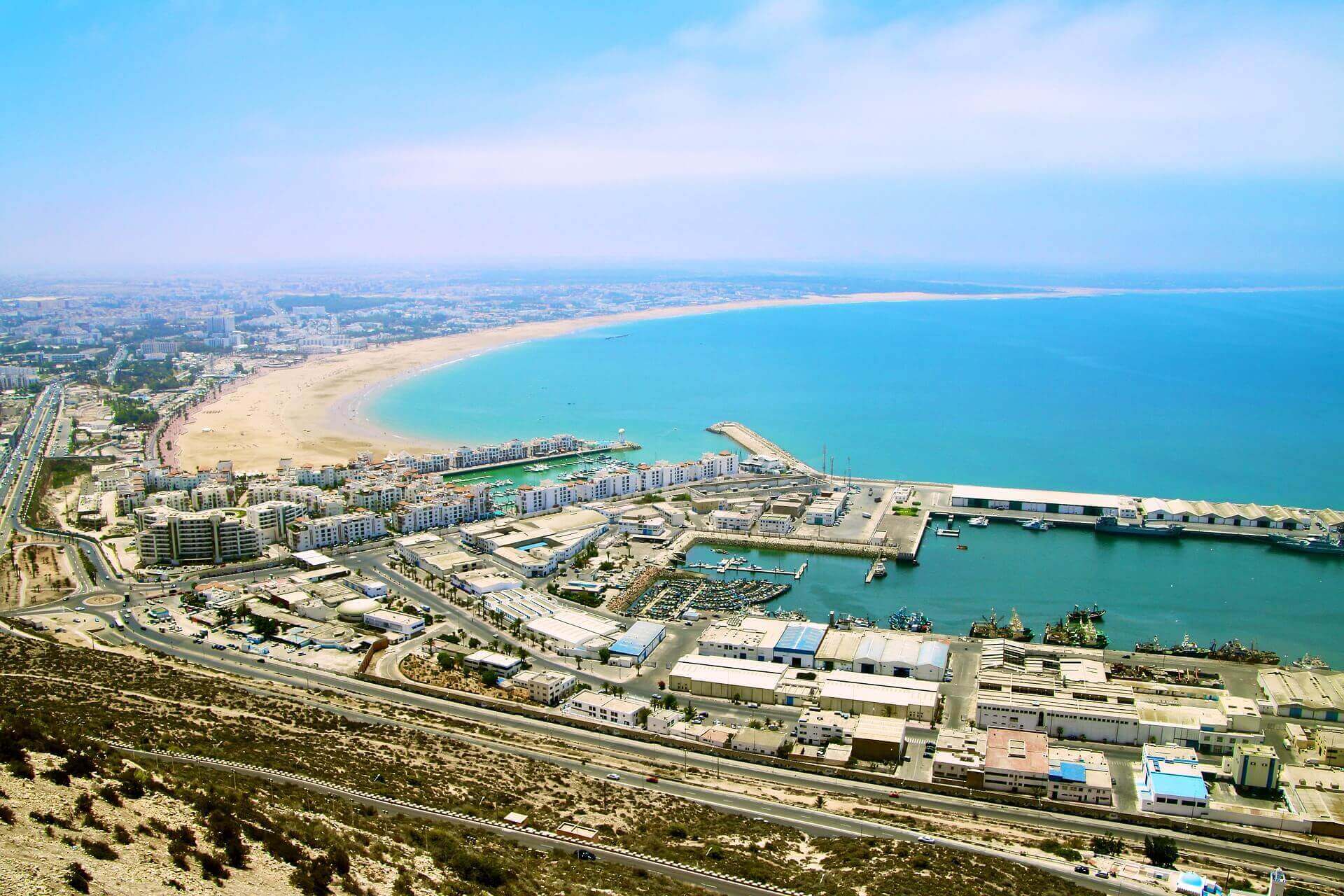
Discover The Best Of Agadir
Agadir (Arabic: أݣادير, romanized: ʾagādīr; Tachelhit: ⴰⴳⴰⴷⵉⵔ) is a major city in Morocco, on the shore of the Atlantic Ocean near the foot of the Atlas Mountains, just north of the point where the Souss River flows into the ocean, and 509 kilometres (316 mi) south of Casablanca. Agadir is the capital of the Agadir Ida-U-Tanan Prefecture and of the Souss-Massa economic region. The majority of its inhabitants speak Berber, one of Morocco’s two official languages.
Agadir is one of the major urban centres of Morocco. The municipality of Agadir recorded a population of 924,000 in the 2014 Moroccan census. According to the 2004 census, there were 346,106 inhabitants in that year and the population of the Prefecture of Agadir-Ida Outanane was 487,954 inhabitants. Three languages are spoken in the city: Tashelhit (first language of the majority), Moroccan Arabic, and French.
It was the site of the 1911 Agadir Crisis that exposed tensions between France and Germany, foreshadowing World War I. The city was destroyed by an earthquake in 1960; it has been completely rebuilt with mandatory seismic standards. It is now the largest seaside resort in Morocco, where foreign tourists and many residents are attracted by an unusually mild year-round climate. Since 2010 it has been well served by low-cost flights and a motorway from Tangier.
The mild winter climate (January average midday temperature 20.5 °C/69 °F) and good beaches have made it a major “winter sun” destination for northern Europeans.
Etymology
The name Agadir is a common Berber noun agadir meaning ‘wall, enclosure, fortified building, citadel’. This noun is attested in most Berber languages, and may be a loanword from Phoenician-Punic, a Semitic language spoken in North Africa in antiquity.
There are many more towns in Morocco called Agadir. The city of Agadir’s full name in Tashelhit is Agadir n Yighir, literally ‘the fortress of the cape’, referring to the nearby promontory named Cape Ighir on maps (a pleonastic name, literally ‘Cape Cape’). Ighir in Berber refers to a mountain or a hill.
A single male inhabitant or native of the town is known in Tashelhit as a gg ugadir (also a common surname, Gougadir in French spelling), plural ayt ugadir ‘men of Agadir’ (also a collective name, ‘men and women of Agadir, people of Agadir’); a single feminine inhabitant is a ult ugadir ‘woman of Agadir’, plural ist ugadir ‘women of Agadir’. In Moroccan Arabic, an inhabitant is a agadiri, plural agadiriyin, feminine agadiriya, plural agadiriyat.
Numismatic inscriptions in the Phoenician language record that the Phoenicians knew Cádiz as a Gadir or Agadir (Phoenician: 𐤀𐤂𐤃𐤓, ʾgdr), meaning ‘wall’, ‘compound’, or (by metonymy) ‘stronghold’. Borrowed into Berber languages, this became agadir (Tamazight: ‘wall’; Shilha: ‘fortified granary’), a word that is common in North African place names.
History
Phoenicians from Tyre founded Agadir (alternately, “Gadir”) around 1104 BC. There is little record of the area before that time.
The oldest known map that includes an indication of Agadir is from 1325: at the approximate location of the modern city, it names a place it calls Porto Mesegina, after a Berber tribe name that had been recorded as early as the 12th century, the Mesguina (also known as the Ksima).
At the end of the medieval period, Agadir was a town of some renown. The first known mention of its name, Agadir al-harba, was recorded in 1510.
In 1505, the Portuguese, who were already installed on the Moroccan coast, founded a trading post and a fort at the foot of a hill near the sea, Santa Cruz do Cabo de Aguer, on the site of the now-vanished neighborhood of Founti (named after the Portuguese word fonte meaning fountain).
The Portuguese installed a governor there, but they were quickly opposed by pre-existing tribes in the region who were hostile to their presence. Beginning in 1530, they were blockaded in Santa Cruz. Portuguese weakness showed itself on 12 March 1541 when Sherif Saâdien Mohammed ash-Sheikh captured the fortress of Santa Cruz de Aguer. Six hundred Portuguese survivors were taken prisoner, including the governor, Guterre de Monroy, and his daughter, Dona Mecia. The captives were redeemed by the holy men, who were mostly from Portugal. Dona Mecia, whose husband was killed during the battle, became the wife of Sheikh Mohammed ash-Sheikh but died in childbirth in 1544. In the same year, Mohammed ash-Sheikh released Guterre de Monroy, whom he had befriended.
After this, the Portuguese were forced to abandon most of the Moroccan areas that they had acquired control of between 1505 and 1520, including Agadir, Safi and Azemmour. By 1550, Portugal’s only holding in Morocco was Mazagan (now El Jadida), Tangier and Ceuta. As Morocco became less important to the Portuguese, they turned their attention to India and Brazil.
The story of the Portuguese presence (from the installation in 1505 until their defeat on 12 March 1541) is described in a manuscript (published for the first time, with a French translation by Pierre de Cenival, in 1934) entitled “Este He O Origem e Comeco e Cabo da Villa de Santa Cruz do Cabo de Gue D’Agoa de Narba”, written by an anonymous author who was captured in 1934 and was imprisoned for five years in Taroudannt (cf. “Santa Cruz do Cabo de Gue d’Agoa de Narba – Estudo e Crónica”, Joao Marinho e Santos, José Manuel Azevedo e Silva e Mohammed Nadir, bilingual edition, Viseu 2007).
In 1572, the Casbah was built on top of the hill by Abdallah al-Ghalib, successor to Mohammed ash-Sheikh. It was now called Agadir N’Ighir, literally: fortified granary of the hill in Tachelhit.
In the 17th century, during the reign of the Berber dynasty of Tazerwalt, Agadir was a harbour of some importance, expanding its trade with Europe. There was, however, neither a real port nor a wharf. Agadir traded mainly in sugar, wax, copper, hides and skins. In exchange, Europeans sold their manufactured goods there, particularly weapons and textiles. Under the reign of Sultan Moulay Ismail (1645–1727) and his successors, the trade with France, which had previously been an active partner, diminished, and trade with the English and Dutch increased.
The entrance of the Casbah.
In 1731, the town was completely destroyed by an earthquake. After that, Agadir’s harbour was ordered to be closed, and an alternative, Essaouira, was established farther north.
After a long period of prosperity during the reigns of the Saadian and Alawite dynasties, Agadir declined from 1760 because of the pre-eminence given to the competing port of Essaouira by the Alawite Sultan Mohammed ben Abdallah who wanted to punish the Souss for rebelling against his authority. This decline lasted a century and a half. In 1789, a European traveler gave a brief description of Agadir: “It is now a ghost town, there are no more than a few houses and these are crumbling into ruins”.
In 1881, Sultan Moulay Hassan reopened the harbour to trade in order to supply the expeditions he planned in the south. These expeditions, which were to reassert his authority over the Souss tribes and counter the plans of English and Spanish, were held in 1882 and 1886.
Map of Agadir in 1885 by Jules Erckmann
In 1884, Charles de Foucauld described in Reconnaissance au Maroc (Reconnaissance in Morocco) his rapid passage to Agadir from the east:
I walk along the shore to Agadir Irir. The road passes below the city, half-way between it and Founti: Founti is a miserable hamlet, a few fishermen’s huts; Agadir, despite its white enclosure which gives it the air of a city is, I am told, a poor village depopulated and without trade.
On the pretext of a call for help from German companies in the valley of the Souss, Germany decided on 1 July 1911, to extend its interests in Morocco and assert a claim on the country. It sent to the Bay of Agadir, (which harbour was, until 1881, closed to foreign trade) the SMS Panther which was quickly joined by the cruiser Berlin. Very strong international reaction, particularly from Great Britain, surprised Germany and triggered the Agadir Crisis between France and Germany. War threatened. After tough negotiations, a Franco-German treaty was finally signed on 4 November 1911, giving a free hand to France, who would be able to establish its protectorate over Morocco in return for giving up some colonies in Africa. It was only then that the gunboat Panther and the cruiser Berlin left the bay of Agadir. Due to a miscalculation, the German sales representative Hermann Wilberg, who was sent to provide the pretext for the intervention, only arrived at Agadir three days after the Panther arrived.
In 1913, the cities (Agadir N’Ighir and Founti) totalled less than a thousand inhabitants. On 15 June 1913 French troops landed in Agadir. In 1916, the first pier was built near Founti – a simple jetty, later known as the “Portuguese jetty”, which remained until the end of the 20th century. After 1920, under the French protectorate, a port was built and the city saw its first development with the construction of the old Talborjt district located on the plateau at the foot of the hill. Two years later, beside Talborjt along the faultline of the river Tildi construction of the popular district of Yahchech began.
Around 1930, Agadir was an important stop for the French airmail service Aéropostale and was frequented by Saint-Exupéry and Mermoz.
In the years from 1930, a modern central city began to be built according to the plans of the urban planner Henri Prost, director of the Urban Planning Department of the Protectorate, and his deputy Albert Laprade: a horseshoe layout based on the waterfront around a large avenue perpendicular to the waterfront – the Avenue Lyautey, since renamed Avenue du Général Kettani. In the 1950s, urban development continued under the direction of the Director of Urban Planning Morocco, Michel Ecochard.
After 1950 and the opening of the new commercial port, the city grew with fishing, canning, agriculture, and mining. It also began to open up to tourism due to its climate and hotel infrastructure. Several years later from 1950 to 1956 Agadir organised the Grand Prix of Agadir [fr] and, from 1954 to 1956, the Moroccan Grand Prix.
In 1959, the port was visited by the yacht of the Greek shipping magnate Aristotle Onassis and his guest, Winston Churchill.
By 1960, Agadir numbered over 40,000 residents when at 15 minutes to midnight on 29 February 1960, it was again almost totally destroyed by an earthquake of magnitude 5.7 on the Richter scale that lasted 15 seconds, burying the city and killing more than a third of the population. The death toll was estimated at 15,000. The earthquake destroyed the ancient Casbah.









This is the best tour on the east coast! It was amazing how many places we visited and what great memories we made!
This was not our first time going to here. It is a great place to shop not too far from New York. We took the bus from Port Authority and traveled through the countryside to get there.
We always stay at here when in town. The location is great, staff is wonderful and we love the overall feel. Beautiful view from the here.